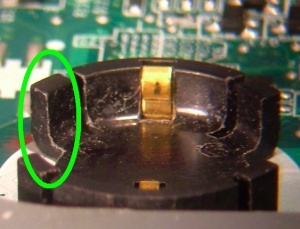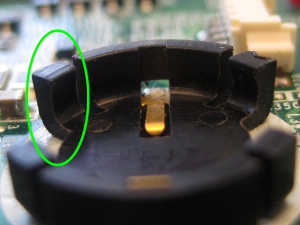Fix Clock/lang-es
Por favor, ayúdanos arreglar la traducción de este pagina
Esta pagina trata de como arreglar un laptop XO segura, que esta dañada con una problema del reloj de tiempo real (RTC).
Descripción de el Problema
Los Laptops XO con este problema pueden mostrar alguno de los siguientes dos síntomas:
- El LED de poder se enciende, pero la pantalla no se enciende (ni siquiera la luz de fondo). El LED de micrófono puede parpadear brevemente, pero se queda apagado. Este síntoma puede ocurrir solamente con las versiones Q2D05 y Q2D06 de OFW.
- La pantalla se ilumina, y muestra "Invalid System Date". Luego se apaga. Este síntoma puede ocurrir con cualquier version de OFW.
El problema es causado por mala información de fecha almacenada en el reloj de tiempo real (RTC) chip. Hay tres maneras en que la fecha podría llegar a ser mala:
- La fábrica no ha fijado la fecha. Esto es muy raro.
- El usuario explícitamente ha fijado la fecha con un valor incorrecto, ya sea por error o para intentar derrotar la activacíon. Esto tambien es raro.
- El chip RTC ha perdido todo su poder. Esto debería haber sido raro en laptops con menos de cinco años de edad, porque el chip RTC tiene una pila de botón que los poderes el RTC chip cuando la poder externa y la batería principal no están presentes. Por desgracia, algunas de las primeras máquinas de producción se han fabricado con un defectuoso titular de la pila de botón. En esas máquinas, la pila de botón puede ser suelto o a cabo enteramente en condiciones normales de manipulación y envío.
"RTC chip ha perdido su poder" es la causa más común de esta problema.
Proceso de Reparación
La solución de este problema se realiza en tres fases:
- Asegurar la batería en la base para que el problema no vuelva a suceder
- Establecer la fecha
- Actualizar Open Firmware a la versión más reciente.
Lo que vas a necesitar
Véase la Guía de Desmontaje. Para asegurar la pila de RTC, necesitará un poco de pegamento, tal como se describe más adelante.
Los requisitos para el resto de la reparación dependerá de cuál de los dos síntomas muestra la laptop:
- Si la pantalla no se enciende (síntoma 1), tendrá un adaptador de hardware - una OLPC adaptador de serie - y una segunda computadora (XO o otro tipo).
- Si la pantalla se enciende (síntoma 2), usted necesitará una "llave de desarrollador" para esta máquina, en un llave USB.
Arregla la pila suelta
Para acceder a la pila de RTC, siga las instrucciones para retirar la cubierta posterior.
First, you must re-seat the coin cell battery in its holder and secure it so it doesn't come out again. One way to secure it is to put a drop of glue where the battery contacts the holder, away from the metallic contact. The best glue that Mitch has found for this purpose is clear solvent-based household cement. Technically, it is "nitro cellulose" cement. It is also known as "model airplane glue", marketed under various trade names such as "Duco Cement", "Tarzan's Grip". Loctite "Stik'n Seal", etc. (Alleskleber, in Germany, maybe?) The solvent in this kind of cement is toxic and flammable, so keep it away from children! Stronger adhesives like epoxy or cyanoacrylate (super glue) would probably work too, but it might be difficult to remove the battery later without damaging the holder. Don't even think of "Gorilla Glue"; that's polyurethane, which foams as it cures. RTV silicone would be good, except that the common variety releases corrosive acetic acid as it cures - if it smells like vinegar, don't use it on electronics. Ordinary "white glue" (PVA, or polyvinyl acetate) will probably work, but it flows easily and goes down underneath the battery - that is probably okay if you are careful not to use too much. Hot melt glue doesn't work, because it doesn't stick very well to these materials.
Proceso Serial - para síntoma 1 (pantalla no se encendia)
Tienes que desmontar la laptop para acceder a la placa madre.
Connecte la laptop a otro por el interface serial
- Usando un adaptador de serie OLPC, conecte el laptop a otro computadora. El adaptador de serie debe estar conectado a J1, en la placa madre del laptop. J1 es un pequeño conector blanco cerca del módulo inalámbrico.
- Use un programa como minicom (para Linux) o HyperTerminal (para Windows) para acceder al laptop por el puerto serie.
- El puerto serie debe ser la configuración de 115200 baud, 8 bits de datos, sin paridad y 1 bit de parada
Se sugiere la práctica para poner a prueba las comunicaciones con una laptop conocida buena, antes de probar los laptops rotos!
Llegar a la prompt
Deben entrar todos estos comandos en el "otro" conmputadora que se conecta por cable serie a el laptop con el mal reloj
- Encienda la laptop que estas arreglando. Usted debe ver "Page Fault" en la terminal serie, seguido por un prompt de "ok". Si no aparece "Page Fault", hay varias posibilidades:
- Si no aparece nada en la terminal serie, ya sea
- La terminal serie no está conectado correctamente, o
- Otra cosa es un error con la máquina - la máquina es bastante muerto y no es una instancia del problema RTC.
- Si ves un montón de mensajes de inicio, pero el último no es un "Page Fault" seguido de "ok", entonces la laptop funcciona. El problema no es del reloj de tiempo real (RTC). Si la pantalla se enciende, debe estar siguiendo el "Procedimiento de Desarrolladores clave".
- Si no aparece nada en la terminal serie, ya sea
- Para establecer la fecha, hacer los siguientes comandos en el prompt ok (oprimir la tecla Enter después de cada uno):
ok select /rtc ok decimal ok seg min hora dia mes año set-time
- seg, min, hora, dia, etc., en el comando anterior deben ser numeros del fecha corriente. Por ejemplo:
ok 00 48 3 13 12 2007 set-time
- Inserte una llave USB que contiene la última versión de firmware. Usted tendrá que descargar el .rom archivo y colocarlo en la llave.
- Para actualizar el firmware, escriba la siguiente línea de comandos a el prompt (ok), sustituyendo la correcta nombre .rom del archivo:
ok probe-pci probe-usb flash u:\q2d16.rom
- La laptop debe reiniciar el sistema automáticamente después. A continuación, puede saccar el llave USB y el sistema debería funcionar correctamente. Puede desconectar el adaptador de serie y reensamblar la laptop.
Como establecer un XO como terminal serie
En vez de usar una computadora no-XO para conectar al laptop que estas arreglando, tambien puedes usar un XO.
- Instale cualquier construir (656 o posterior)
- Enciende la laptop y conectarse a Internet.
- Abra el terminal y tipiar: yum install minicom
- Una vez que se realiza, configure minicom escribiendo: minicom -s
- Ir a "Serial Port Setup" y pulsa "Enter".
- Pulse 'a' y cambiarlo a "/dev/ttyUSB0". Después, pulsa "Enter" dos veces.
- Ir a "Modem and Dialing" y pulsa "Enter".
- Borrar el contenido de ambos 'Init string' y 'Reset string' (llegar a esos con 'a' y 'b')
- Pulse "Enter" para volver a la menú 'configuración'.
- Ir a "Save setup as .." y pulsa "Enter".
- Da un nombre a la configuración como «USB0" y pulsa "Enter".
- Ir a "Exit from Minicom" y pulsa "Enter".
- Ahora, para abrir minicom con las opciones que desee todo lo que tiene que hacer es teclear:
minicom USB0
Proceso Llave Desarollador - para síntoma 2 (pantalla se encendia)
Deben entrar todos estos comandos en la laptop con el reloj dañado
- Obtenga una "llave desarrollador" para este laptop y ponerla en un llave USB
- También ponga el última versión de firmware en la llave USB. Usted tendrá que descargar el .rom archivo y colocarlo en la llave.
- Inserte la memoria USB en la laptop
- Encienda la laptop
- Cuando la pantalla diga "Type the Esc key to interrupt automatic startup", inserte la memoria USB en la laptop antes de que la cuenta expire. Usted debe recibir un "ok" pronto. (Si no ves ese mensaje, algo está mal con el clave USB.)
- Tipiar estos comandos para cambiar la fecha (oprimir la tecla "Enter" después de cada uno):
ok select /rtc ok decimal ok seg min hora dia mes año set-time
- seg, min, hora, dia, etc.en el comando anterior deben ser numeros del fecha corriente. Por ejemplo:
ok 00 48 3 13 12 2007 set-time
- Para actualizar el firmware, escriba la siguiente línea de comandos a el prompt (ok), sustituyendo la correcta nombre .rom del archivo:
ok flash u:\q2d16.rom
- La laptop debe reiniciar el sistema automáticamente después. A continuación, puede saccar el llave USB y el sistema debería funcionar correctamente.

